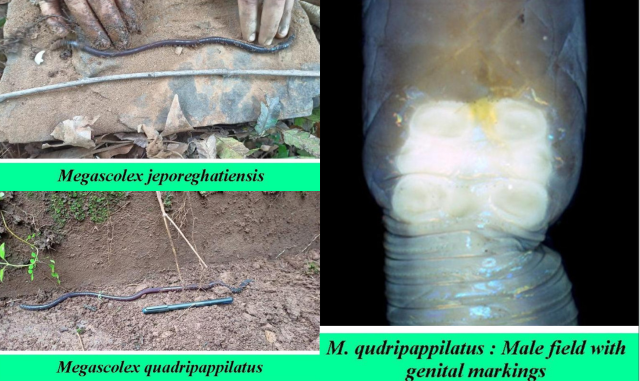In a groundbreaking discovery, researchers from the Central University of Odisha, Koraput, in collaboration with scientists from Mahatma Gandhi University, Kottayam, Kerala, have unearthed two previously unknown species of Megascolex earthworms from the Eastern Ghats of Odisha. During an earthworm diversity study conducted in different parts of Koraput, Ms. Ayusmita Naik collected some large earthworm specimens from Rani Duduma and the Jeypore Ghati area of Koraput. Under the supervision of Prof. Sharat Kumar Palita, Dean of the School of Biodiversity and Conservation of Natural Resources of the Central University of Odisha (CUO), Koraput, the specimens were carefully examined in the laboratory by the researchers. Later with the support of Dr. R. Paliwal, Retd. Scientist of the Zoological Survey of India and Earthworm specialists Dr. Prasantha Narayanan and Dr. A.P. Thomas of Advanced Centre of Environmental Studies and Sustainable Development, Mahatma Gandhi University, Kottayam, Kerala these two large earthworm varieties were identified as two new species which are completely new to science. They were identified as Megascolexjeyporeghatiensis and Megascolexquadripappilatus. The report of these two new species from Koraput has been published in the reputed international taxonomic journal Zootaxa.
These two new earthworm species belong to Genus Megascolex discovered from relatively under-explored Eastern Ghats hills of Odisha state in Peninsular India. They belong to a group of species characterized by two pairs of spermathecal pores in intersegmental furrows 7/8/9, holandric, seminal vesicles in segments 9 and 12, absence of penial setae and calciferous glands. These two new species occur in deciduous forests with brownish gravel-loamy soils.
These two species are endemic to India: Odisha State: Koraput District: Jeypore Ghati and Rani Duduma. With this discovery, the total number of Megascolexspecies in the world has increased to 70, of which 34 are found in India. In India, mostly all Megascolex species are restricted to the southern portion of the Western Ghats mountain ranges in the southwest corner of Peninsular India. With the discovery of these new species, the range of Megascolex groups of earthworms has been further extended into northern Peninsular India into northern Eastern Ghats.
The new species M. jeyporeghatiensiswas discovered at an altitude of 862 m a.s.l. from the moist deciduous forests of Jeypore Ghati area 10 m away from a non-perennial stream from the roots of a pteridophyte plant (Athyrium sp.). This species was also found near a stream in the dry-deciduous forests of Rani Duduma at an altitude of 930 m. a.s.l.. It has been named after Jeypore Ghati of Koraput, Odisha. Genital markings two pairs, clitellum annular, indicated by dark colouration than the rest of the body. The length of these large specimens ranged from 221–281 mm with 168 – 180 segments. Found in both deciduous and moist-deciduous forests of hilly terrain.
The otherspecies M. quadripappilatus discovered only from dry deciduous forests in a hilly terrain near a stream in Rani Duduma forests (25 kms from Semiliguda Town of Koraput) at an altitude of 960 m a.s.l. is named so, because it has four (quadri) unique papillae, which refers to the presence of four genital markings (whitish in colour) of this new species. Its clitellum is annular, protuberant dark coffee-brown colour. The length of this large specimen ranged from 273–308 mm with 188 – 190 segments.
These two new species are anecic worms, found to consume fibrous plant material like barks, woody parts, and leafy material including pebbles and rocky soil.As they live in forest soil high organic biomass, they indicate soil health and maintain soil productivity. Earthworms have the ability to biomonitor soil pollutants are able to perform carbon sequestration and reduce soil pollutants.
The record of these two new species from Koraput in the Eastern Ghats has further highlighted the rich unexplored biodiversity of Koraput as well as the Eastern Ghats region of India. Prof. S. K. Palita, Dean of the School at CUO is optimistic about the discoveries of many new species from this part and further stresses the need for more funding by Govt. bodies for biodiversity research for this rich but unexplored region of Eastern Ghats of Odisha and more conservation attention. Prof. Chakradhar Tripathy, Vice-Chancellor of Central University of Odisha has hailed this as a great achievement for the scientific community of CUO and stressed the need for this type of basic research which can put CUO on the world map. He congratulated the team of researchers involved in this discovery.



Comments are closed.